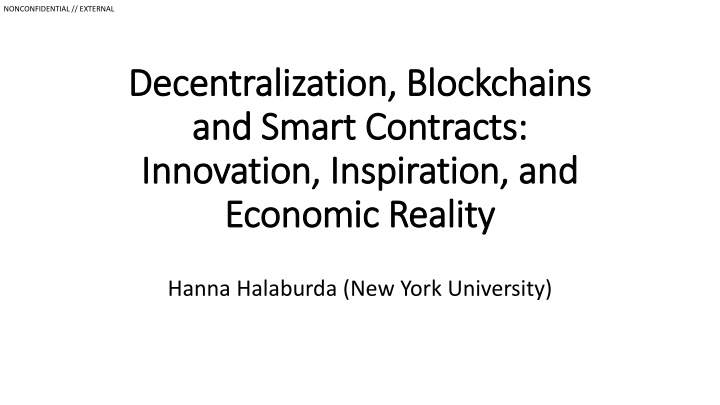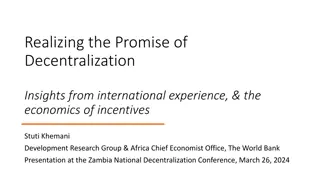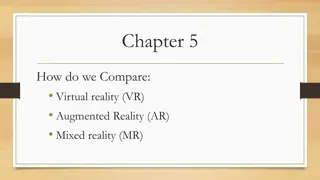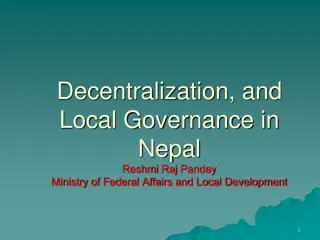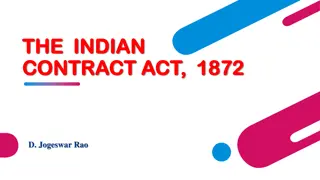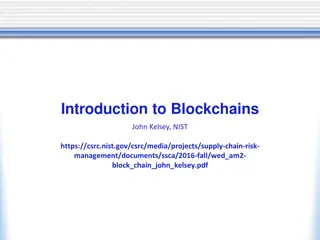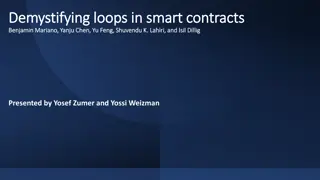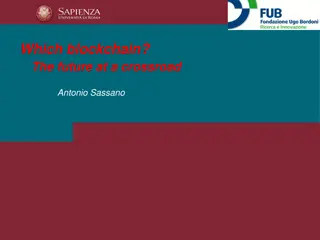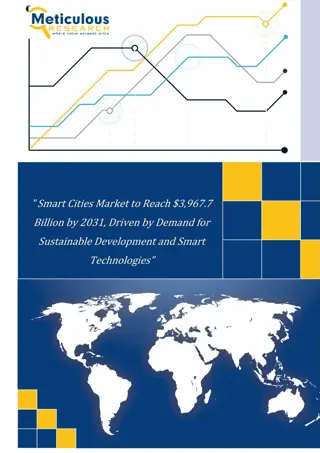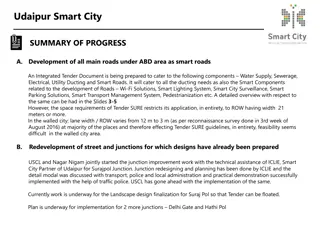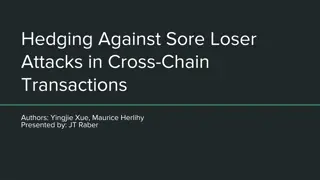Decentralization, Blockchains, and Smart Contracts: Innovation and Economic Reality
The evolution and challenges of decentralization, blockchains, and smart contracts through real-world examples like Bitcoin and general blockchain technology. Understand the limitations, broader applications, and impact on new markets versus old-market problems. Delve into the strengths and restrictions of smart contracts in various scenarios.
Uploaded on Mar 11, 2025 | 5 Views
Download Presentation

Please find below an Image/Link to download the presentation.
The content on the website is provided AS IS for your information and personal use only. It may not be sold, licensed, or shared on other websites without obtaining consent from the author.If you encounter any issues during the download, it is possible that the publisher has removed the file from their server.
You are allowed to download the files provided on this website for personal or commercial use, subject to the condition that they are used lawfully. All files are the property of their respective owners.
The content on the website is provided AS IS for your information and personal use only. It may not be sold, licensed, or shared on other websites without obtaining consent from the author.
E N D
Presentation Transcript
NONCONFIDENTIAL // EXTERNAL Decentralization, Blockchains Decentralization, Blockchains and Smart Contracts: and Smart Contracts: Innovation, Inspiration, and Innovation, Inspiration, and Economic Reality Economic Reality Hanna Halaburda (New York University)
NONCONFIDENTIAL // EXTERNAL Bitcoin Blockchain: A Success Story Technological Achievement: o Permissionless, decentralized ledger o Resistant to double-spending o Support for decentralized digital currency Demonstrated Feasibility: o First successful cryptocurrency o Inspired pursuit of permissionless, decentralized ledgers in other context (DeFi, DAOs, Web3)
NONCONFIDENTIAL // EXTERNAL Bitcoin s Limitations Imperfections of the Protocol: Double-spending issues in many altcoins (e.g.,Ethereum Classic, Bitcoin Gold) Numerous failed blockchain projects High Operational Costs: Energy-intensive Proof of Work (PoW) Congestion on limited thruput network -> high transaction fees Joshua S. Gans, Hanna Halaburda "Zero Cost" Majority Attacks on Permissionless Proof of Work Blockchains. Manag. Sci. 70(6): 4155-4165 (2024)
NONCONFIDENTIAL // EXTERNAL General Blockchain Technology: Broader Applications and Challenges Broader Applications: Supply chain management Healthcare records Governance systems (e.g. DAOs) Integration Challenges: Need to connect with off-chain systems Strong re-centralization forces and decreased resilience Economic and Technical Drivers of Centralization: Market forces favor centralized entities, due to network effects Technical hurdles in maintaining decentralized networks, due to coordination and communication costs Historical Promises of Decentralization: Technology vs incentives Yannis Bakos, Hanna Halaburda The Problem of Credible Decentralization in DAOs. SSRN, (2023)
NONCONFIDENTIAL // EXTERNAL New Markets vs. Old-Market Problems Creation of New Markets and Assets: Example: Collectibles (NFTs), DeFi Failure to Solve Existing Problems: Blockchain hasn t addressed traditional market inefficiencies Overambitious Goals: Decentralize everything was too ambitious a burden for Bitcoin s shoulders
NONCONFIDENTIAL // EXTERNAL Smart Contracts: Strengths and Restrictions Strengths: Automation of transactions Efficiency in specific use cases (e.g., trading functions) Restrictions: Limited applicability across diverse scenarios Dependence on reliable oracles Complexity in implementation High up-front cost in creation for complex uses Hanna Halaburda , Natalia Levina , Semi Min Digitization of Transaction Terms within TCE: Strong Smart Contract as a New Mode of Transaction Governance. MISQ. 48(2): 825-846 (2024)
NONCONFIDENTIAL // EXTERNAL Permissionless vs. Permissioned Blockchains Permissionless Blockchains: e.g., Bitcoin, Ethereum Operate without external authority Limited in solving pre-existing problems Very costly whether PoS or PoW Subject to re-centralization incentives Permissioned Blockchains: Cheaper and more secure With some minimal levels of trust in the punishment for wrongdoing courts, public opinion May be more decentralized than permissionless Yannis Bakos, Hanna Halaburda Permissioned vs Permissionless Blockchain Platforms: Tradeoffs in Trust and Performance. SSRN, (2023) Yannis Bakos, Hanna Halaburda, Christoph M ller-Bloch When permissioned blockchains deliver more decentralization than permissionless. Commun. ACM 64(2), (2021)
NONCONFIDENTIAL // EXTERNAL Do We Even Need a Blockchain? Improving Market Efficiency: Benefits from digitization and automation via smart contracts Is blockchain necessary? Censorship Resistance: Originally designed for censorship resistance Is censorship resistance a primary need in financial systems? Payment Systems without Blockchain Pix (Brazil), Faster Payments (UK), UPI (India), Interac (Canada), Swish (Sweden)
NONCONFIDENTIAL // EXTERNAL Blockchain: Fuel for Innovation or Overhyped Disruption? Catalyst for Innovation: Blockchain hype has sparked a wave of creativity and innovation. Inspiration from blockchain has propelled the development of systems aimed at decentralization and trustless transactions. Real-World Limitations: Despite its promise, large-scale adoption in financial systems is limited by practical, economic, and technological constraints. Key features like decentralization often face re-centralization pressures. Smart contracts applicable in narrow conditions High cost Value of Hype: It has reshaped expectations and advanced other tech solutions, even if much of blockchain's original technology may not directly translate to traditional financial systems.
